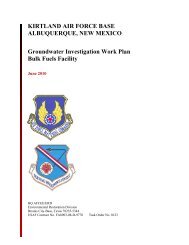Final FONSI and EA for hot cargo pad on Kirtland AFB - Kirtland Air ...
Final FONSI and EA for hot cargo pad on Kirtland AFB - Kirtland Air ...
Final FONSI and EA for hot cargo pad on Kirtland AFB - Kirtland Air ...
You also want an ePaper? Increase the reach of your titles
YUMPU automatically turns print PDFs into web optimized ePapers that Google loves.
<str<strong>on</strong>g>Final</str<strong>on</strong>g> <str<strong>on</strong>g>EA</str<strong>on</strong>g> Addressing C<strong>on</strong>structi<strong>on</strong>, Operati<strong>on</strong>, <str<strong>on</strong>g>and</str<strong>on</strong>g> Maintenance of a Hot Cargo Pad<br />
Storm Water Systems. C<strong>on</strong>structi<strong>on</strong> of the proposed <str<strong>on</strong>g>hot</str<strong>on</strong>g> <str<strong>on</strong>g>cargo</str<strong>on</strong>g> <str<strong>on</strong>g>pad</str<strong>on</strong>g> would require ground disturbance as<br />
heavy equipment would clear, grade, <str<strong>on</strong>g>and</str<strong>on</strong>g> c<strong>on</strong>tour l<str<strong>on</strong>g>and</str<strong>on</strong>g> surfaces. These activities would temporarily<br />
disrupt natural <str<strong>on</strong>g>and</str<strong>on</strong>g> man-made storm water drainage methods, increase sedimentati<strong>on</strong> in runoff, <str<strong>on</strong>g>and</str<strong>on</strong>g><br />
increase the potential <str<strong>on</strong>g>for</str<strong>on</strong>g> storm water runoff to erode soil during c<strong>on</strong>structi<strong>on</strong> activities. Soil erosi<strong>on</strong> <str<strong>on</strong>g>and</str<strong>on</strong>g><br />
sediment producti<strong>on</strong> would be minimized during the c<strong>on</strong>structi<strong>on</strong> period by following erosi<strong>on</strong>- <str<strong>on</strong>g>and</str<strong>on</strong>g><br />
sediment-c<strong>on</strong>trol plans, <str<strong>on</strong>g>and</str<strong>on</strong>g> by using c<strong>on</strong>structi<strong>on</strong> BMPs that would minimize ground surface disturbance<br />
<str<strong>on</strong>g>and</str<strong>on</strong>g> attempt to provide adequate temporary storm water management techniques.<br />
The c<strong>on</strong>structi<strong>on</strong> of the proposed <str<strong>on</strong>g>hot</str<strong>on</strong>g> <str<strong>on</strong>g>cargo</str<strong>on</strong>g> <str<strong>on</strong>g>pad</str<strong>on</strong>g> <str<strong>on</strong>g>and</str<strong>on</strong>g> the associated taxiways, vehicle parking areas,<br />
pers<strong>on</strong>nel shelters, <str<strong>on</strong>g>and</str<strong>on</strong>g> storage sheds could add as much as approximately 11 acres (4.2 acres <str<strong>on</strong>g>for</str<strong>on</strong>g> the<br />
proposed <str<strong>on</strong>g>hot</str<strong>on</strong>g> <str<strong>on</strong>g>cargo</str<strong>on</strong>g> <str<strong>on</strong>g>pad</str<strong>on</strong>g> <str<strong>on</strong>g>and</str<strong>on</strong>g> approximately 7 acres <str<strong>on</strong>g>for</str<strong>on</strong>g> the new taxiway) of new impervious service at the<br />
area of the Proposed Acti<strong>on</strong>. This increase in impervious surface would reduce the amount of surface<br />
area <str<strong>on</strong>g>for</str<strong>on</strong>g> storm water to permeate into the ground <str<strong>on</strong>g>and</str<strong>on</strong>g> increase the amount of storm water runoff.<br />
L<strong>on</strong>g-term storm water management techniques, which might include the use of pipes, channels, culverts,<br />
<str<strong>on</strong>g>and</str<strong>on</strong>g> impoundment basins, would be implemented to reduce <str<strong>on</strong>g>and</str<strong>on</strong>g> c<strong>on</strong>trol the volume of storm water runoff.<br />
The Proposed Acti<strong>on</strong> would result in adverse effects <strong>on</strong> storm water systems; however, with appropriate<br />
BMPs, these effects would be expected to be less than significant.<br />
Communicati<strong>on</strong>s Systems. Because the proposed <str<strong>on</strong>g>hot</str<strong>on</strong>g> <str<strong>on</strong>g>cargo</str<strong>on</strong>g> <str<strong>on</strong>g>pad</str<strong>on</strong>g> <str<strong>on</strong>g>and</str<strong>on</strong>g> the existing <str<strong>on</strong>g>hot</str<strong>on</strong>g> <str<strong>on</strong>g>cargo</str<strong>on</strong>g> <str<strong>on</strong>g>pad</str<strong>on</strong>g> (Pad 5)<br />
would not be used simultaneously <str<strong>on</strong>g>and</str<strong>on</strong>g> the volume of <str<strong>on</strong>g>hot</str<strong>on</strong>g> <str<strong>on</strong>g>cargo</str<strong>on</strong>g> traffic at Kirtl<str<strong>on</strong>g>and</str<strong>on</strong>g> <strong>AFB</strong> would remain<br />
unchanged, no net increase in communicati<strong>on</strong> dem<str<strong>on</strong>g>and</str<strong>on</strong>g> would be expected from the implementati<strong>on</strong> of the<br />
Proposed Acti<strong>on</strong>. The Proposed Acti<strong>on</strong> would not impact the communicati<strong>on</strong> systems of Kirtl<str<strong>on</strong>g>and</str<strong>on</strong>g> <strong>AFB</strong>.<br />
Solid Waste Management. The implementati<strong>on</strong> of the Proposed Acti<strong>on</strong> would generate minimal<br />
quantities of c<strong>on</strong>structi<strong>on</strong> waste. N<strong>on</strong>hazardous c<strong>on</strong>structi<strong>on</strong> waste, such as asphalt, c<strong>on</strong>crete, wood, <str<strong>on</strong>g>and</str<strong>on</strong>g><br />
n<strong>on</strong>recyclable metals, would be transported to the Kirtl<str<strong>on</strong>g>and</str<strong>on</strong>g> <strong>AFB</strong> l<str<strong>on</strong>g>and</str<strong>on</strong>g>fill <str<strong>on</strong>g>for</str<strong>on</strong>g> disposal. Receptacles would<br />
be provided <str<strong>on</strong>g>for</str<strong>on</strong>g> municipal solid waste generated by worker activity. Municipal solid waste would be<br />
transported to the Rio Rancho L<str<strong>on</strong>g>and</str<strong>on</strong>g>fill, because the Kirtl<str<strong>on</strong>g>and</str<strong>on</strong>g> <strong>AFB</strong> l<str<strong>on</strong>g>and</str<strong>on</strong>g>fill accepts <strong>on</strong>ly n<strong>on</strong>hazardous<br />
c<strong>on</strong>structi<strong>on</strong> <str<strong>on</strong>g>and</str<strong>on</strong>g> demoliti<strong>on</strong> waste.<br />
To reduce the amount of l<str<strong>on</strong>g>and</str<strong>on</strong>g>fill waste, materials that could be recycled or reused would be diverted from<br />
l<str<strong>on</strong>g>and</str<strong>on</strong>g>fills to the greatest extent possible. Cardboard wastes would be recycled as a functi<strong>on</strong> of the Kirtl<str<strong>on</strong>g>and</str<strong>on</strong>g><br />
<strong>AFB</strong> Qualified Recycling Program. Miscellaneous salvageable metals would be transported to the<br />
Defense Reutilizati<strong>on</strong> <str<strong>on</strong>g>and</str<strong>on</strong>g> Marketing Office <str<strong>on</strong>g>for</str<strong>on</strong>g> recycling or reuse. Clean fill material, ground up asphalt,<br />
<str<strong>on</strong>g>and</str<strong>on</strong>g> broken-up cement would be diverted from l<str<strong>on</strong>g>and</str<strong>on</strong>g>fills <str<strong>on</strong>g>and</str<strong>on</strong>g> reused whenever possible.<br />
Following the implementati<strong>on</strong> of the Proposed Acti<strong>on</strong>, the amount of solid waste generated at Kirtl<str<strong>on</strong>g>and</str<strong>on</strong>g><br />
<strong>AFB</strong> would not increase due to the operati<strong>on</strong> <str<strong>on</strong>g>and</str<strong>on</strong>g> maintenance of the proposed <str<strong>on</strong>g>hot</str<strong>on</strong>g> <str<strong>on</strong>g>cargo</str<strong>on</strong>g> <str<strong>on</strong>g>pad</str<strong>on</strong>g>. There<str<strong>on</strong>g>for</str<strong>on</strong>g>e,<br />
the Proposed Acti<strong>on</strong> would result in adverse effects <strong>on</strong> solid waste resources.<br />
4.9.2.2 No Acti<strong>on</strong> Alternative<br />
The No Acti<strong>on</strong> Alternative would result in c<strong>on</strong>tinuati<strong>on</strong> of the existing c<strong>on</strong>diti<strong>on</strong>s of infrastructure<br />
resources, as discussed in Secti<strong>on</strong> 3.9.2. No additi<strong>on</strong>al effects <strong>on</strong> infrastructure resources would be<br />
expected as a result of the Proposed Acti<strong>on</strong> not being implemented.<br />
Kirtl<str<strong>on</strong>g>and</str<strong>on</strong>g> <strong>AFB</strong>, NM January 2011<br />
4-16
















